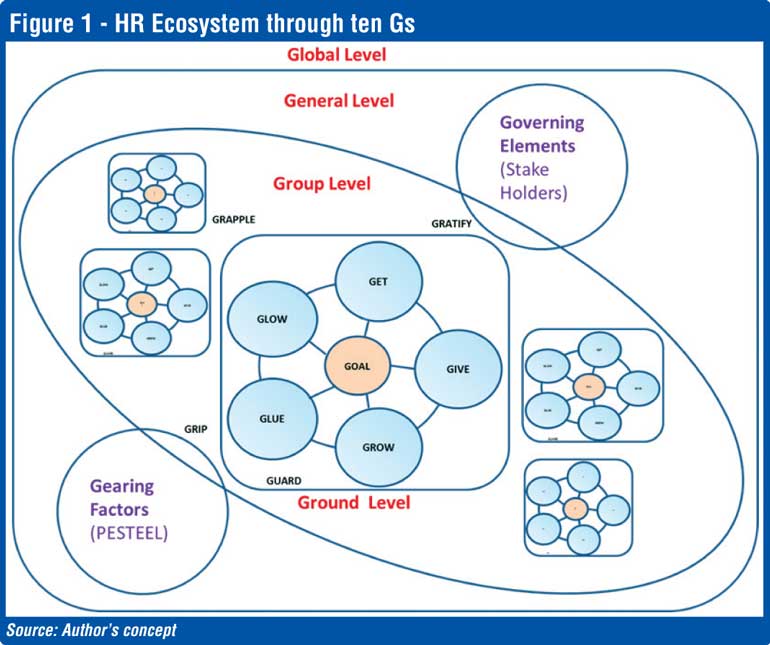Sunday Jan 11, 2026
Sunday Jan 11, 2026
Monday, 28 February 2022 00:00 - - {{hitsCtrl.values.hits}}

Overview
While the country is experiencing chaos in multiple fronts, focus on people has been significant as never before. Right people doing the right things in producing right results within the right timeframe with the use of right resources is relevant in reviving the ailing systems. In such a context, viewing people management through an ecosystem perspective offers fresh insights for resilience and revival. Today’s column attempts to deliberate on it.
with the use of right resources is relevant in reviving the ailing systems. In such a context, viewing people management through an ecosystem perspective offers fresh insights for resilience and revival. Today’s column attempts to deliberate on it.
HRM as an ecosystem
Can the practice of Human Resource Management (HRM) be meaningfully viewed as an ecosystem? The answer is yes. Perhaps the first step is to comprehend the nature and features of an ecosystem.
Eco systems are so essential for the nature. They provide basis for survival and sustainability. An ecosystem can be described in multiple ways. The typical biology textbooks call it a community of living organisms. It can further be described as a group of interconnected elements, formed by the interaction of a community of organisms with their environment. It appears that the business world has borrowed the term from biology and adapted it to suit the business needs. As such, it can be views as any system or network of interconnecting and interacting parts.
The essential feature of an ecosystem is the lively interactions among the elements. It is a dynamic set of interrelationships that create value. An ecosystem can be influenced by internal as well as external factors. The scope and the space of an ecosystem may vary. In fact, the entire planet has been identified as a mega ecosystem.
HR ecosystem through ten Gs
It is indeed fascinating to see how HRM operates at various levels within an institution as well as outside an institution. I propose an HR ecosystem as a combination of ten Gs, namely, Goal, Get, Give, Grow, Glue, Glow, Guard, Grapple, Grip and Gratify. They are related mainly to four levels, from micro to macro. I would identify them as Ground, Group, General and Global. Figure 1 illustrates such multiple facets in multiple levels.
Let’s go through the details of the ten Gs depicted in figure 1 with examples.
Ground level
I propose this as the institutional or organisational context. It could be private or public. The first seven Gs are very much in existence here.
Goal
This occupies the centre stage in setting the direction of the entire organisation. It revolves around the strategic intent, comprising vision, mission, or aspiration whatever the terminology may be. Aligning the grooming of people with goals of the organisation should be the right approach. There are numerous occasions where people are unclear about their top goals and priorities.
Strategic Human Resource Management (SHRM) appears prominently in this context. SHRM is an approach that defines how an organisation’s goals will be achieved through people by means of HR strategies and integrated HR policies and practices.
Get
This is all about getting the right people in. The hiring challenge looms large for organisation in diverse environments, mainly owing to a talent gap. I would call it R-R gap, the gap between required talent and raw talent. The market is abundant with raw talent, especially with school leavers. Are they geared to a demanding job in a target-driven environment? Sadly, the answer is no. We teach complex subject matter but not how to gain confidence. Job-orientation in the academic courses has been recognised as important only of late.
In practical terms, updated job descriptions and job specifications should be available for each position and these should be used in the selection process. Also, selecting the appropriate test in predicting future performance on the specific job is of importance. Managers should be trained on effective hiring, with special emphasis on interviewing skills.
Grow
This refers to the need to build people. Training and development go hand in hand. The simple difference is that the former is for current, and the latter is for future. In essence, training is to do something. Development is to be someone. Both are intertwined in such a way that training leads to development.
Choices in training and development are captured here. Identification of training and development needs is of utmost importance in this regard. Having clarity on programme participants, presenters, designers, coverage, delivery methods and expected behavioural changes are some of the vital components associated.
A growing emphasis on training effectiveness with proper mechanisms to measure is seen in the Sri Lankan private sector. Use of the popular Kirkpatrick model to assess training effectiveness at different levels is one such approach. Return on Training Investment (ROTI) has slowly become a critical factor in the local scenario as well, in justifying the monetary allocation for training and development.
Give
“If you give peanuts, you get monkeys”, goes the old saying. What you give to the person who came in by way of reward and recognition is of utmost importance in the context of competition. Your competitor can grab our best talent by “giving” more.
One may observe that some Sri Lankan organisations have well-structured reward and recognition schemes. What is needed more could be strengthening of the behavioural aspects, such as verbal appreciation of exceptional performance.
Glue
I would associate the feature “binding” with glue. This refers to the range of choices in retaining talent. Having developed the knowledge and skills of high performers of any organisation, seeing them leaving is the last thing an organisation would like to see. The multi-faceted phenomenon of employee engagement needs to be dealt with appropriate strategies.
Finding out why talented people leave and taking appropriate actions to arrest the outflow should be high in the HR agenda. Offering of a variety of financial and non-financial rewards to stay has also needs to be strengthened.
Encouraging evidence can be found in many leading organisations in Sri Lanka. Yet, the reality remains that, when overseas opportunities are galore with unmatchable financial offers, employees tend to seek better prospects. As I have seen in many organisations, effectively engaging the employees with a clear purpose can be a sure-cure in arresting the rot.
Glow
This is the subtlest of all. It can appear in several forms. As one such form, choices in promoting the employees can be captured. When a career ladder is available for them to climb, and when the organisation is genuinely providing the support and encouragement, chances of them contributing better in a more committed manner is high. Establishing criteria for new jobs, allowing volunteers to take up challenging tasks, evaluating candidates’ potential, supporting of new job holders are some of the key actions in this regard. The broad aspects of performance management fall into this arena.
In another form, encouraging the employees to unleash their potential is also a way of allowing them to “glow”. Creating an environment where employees feel free to experiment, resulting in innovative products and services is a right step in this direction. Global examples such as 3M and Google have made this a sure-fire approach in making people glow.
Guard
Guarding is all about the employee protection through a proper policy framework. It may include controls as well as clearance for creative action. A widely shared and wilfully practiced set of corporate values also falls into this perspective. A weak guarding may result in employees having uncertainty and ambiguity with regard to their direction, resulting in lower involvement and contribution.
The above seven Gs are interrelated and in existence in institutions. Let’s move one step further. When many such institutions in an industry have seven Gs, there is much greater prospects for HRM to prosper.
Group level
I use the term “Group” to identify many institutions in an industry. Several apparel manufacturers having seven Gs of HRM in the apparel industry is such an example. The eighth G, Grapple is required here.
Grapple
It is the reality of competition among various institutions to grab the best talent. It also highlights the way to handle possible conflicts or collaborations between different institutions with regard to HRM. Among the competing organisations, how HRM practices can be shared and supported is worth exploring. In essence, grapple refers to the challenges of facing competition among the firms and how HRM should respond to such challenges.
In the diagram of HR Ecosystem, several institutions having seven Gs of HRM are represented with eighth G as an institutional HRM response to the industry. This in fact can be further extended to more than one industry as well.
General level
This is where all industries with many institutions meet. It is essentially the broad national level where country-wide HRM policies and practices become significant. This is where twin influences occur with regard to industries and thereby the institutions within. I would like to call them gearing factors and governing elements.
Gearing factors:
These are the typical PESTEEL factors that gear or influence the steering of an industry or the institutions within. PESTEEL stands for political, economic, social, technical, environmental, ethical, and legal factors. They affect an industry in general and an institution in specific. What is the implication to HRM? It is a case of having a grip on the gearing factors in making HRM policies. I propose this aspect as the ninth G, Grip.
Grip
In essence, it is the collective and committed HRM response to the gearing factors. Let’s say a policy decision of allowing knowledge workers from a neighbouring country is taken. There is a need for HR professionals to discuss, decide and do the needful in such an event. That is to take a firm “grip” in responding to the influencing factor. It is a significant step in staying competitive as a nation.
Apart from the gearing factors, governing forces need our attention.
Governing elements
These are the stakeholders having diverse expectations. They include government, labour unions, HR professional bodies, HR research units etc. What is required from HRM is the tenth G, which is to “gratify”.
Gratify
This essentially refers to stakeholder satisfaction. HRM has a macro role here. HR professionals have to connect, cooperate, and collaborate with multiple institutions, communities, and organisations at national level. These moves provide the key drivers for being more competitive as a nation.
Having discussed ground, group and general levels what is left is the global level.
Global level
This is where national competitiveness of a country matters most. For us to be more competitive as a nation at global level, HRM should produce global talent from Sri Lanka. HR professionals have a critical role in ensuring seven Gs at ground level, eighth G at group level and the remaining Gs at general level. The current indications such as the Global Competitiveness Index reveal a significant area for improvement in this respect. It is the culmination of all Gs that HRM has to offer in order for the country to be globally more competitive.
Way forward
Revisiting HRM through an ecosystem to discover its depth and breadth is not just a conceptual act but points to concrete actions towards goal attainment. Particularly in the “new normal” where fresh thoughts and focused actions are required by all professionals in order to tackle the pressing issues. The role HR professionals have to play is getting increasingly important with the associated complex challenges.
(The writer is the immediate past Director of the Postgraduate Institute of Management, and can be reached through [email protected], [email protected] or www.ajanthadharmasiri.info.)